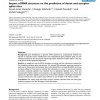BMCBI
2004
14 years 9 days ago
2004
Background: Many current gene prediction methods use only one model to represent proteincoding regions in a genome, and so are less likely to predict the location of genes that ha...
BMCBI
2005
14 years 10 days ago
2005
Background: The Generalized Hidden Markov Model (GHMM) has proven a useful framework for the task of computational gene prediction in eukaryotic genomes, due to its flexibility an...
BMCBI
2005
14 years 10 days ago
2005
Background: Alternative splicing (AS) is now considered as a major actor in transcriptome/ proteome diversity and it cannot be neglected in the annotation process of a new genome....
BMCBI
2006
14 years 15 days ago
2006
Background: gene identification in genomic DNA sequences by computational methods has become an important task in bioinformatics and computational gene prediction tools are now es...
BMCBI
2006
14 years 15 days ago
2006
Background: In order to improve gene prediction, extrinsic evidence on the gene structure can be collected from various sources of information such as genome-genome comparisons an...
BMCBI
2008
14 years 17 days ago
2008
Background: While the C. elegans genome is extensively annotated, relatively little information is available for other Caenorhabditis species. The nematode genome annotation asses...
BMCBI
2010
14 years 17 days ago
2010
Background: The decrease in cost for sequencing and improvement in technologies has made it easier and more common for the re-sequencing of large genomes as well as parallel seque...
BMCBI
2010
14 years 17 days ago
2010
Background: The quality of automated gene prediction in microbial organisms has improved steadily over the past decade, but there is still room for improvement. Increasing the num...
SDM
2010
SIAM
14 years 1 months ago
2010
SIAM
Gene prediction is one of the most challenging tasks in genome analysis, for which many tools have been developed and are still evolving. In this paper, we present a novel gene pr...

